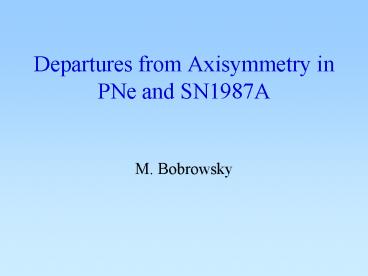Departures from Axisymmetry in PNe and SN1987A - PowerPoint PPT Presentation
Title:
Departures from Axisymmetry in PNe and SN1987A
Description:
Hen 3-1357 (The Stingray Nebula) Central Star Displacement in. the Stingray Nebula ... IRAS 16268-4556 = Hen 2-166. IRAS 20119 2924 = Hen 2-459. Types of Departure ... – PowerPoint PPT presentation
Number of Views:18
Avg rating:3.0/5.0
Title: Departures from Axisymmetry in PNe and SN1987A
1
Departures from Axisymmetry in PNe and SN1987A
- M. Bobrowsky
2
- Axisymmetry is well known. (It forms in the
last part of the superwind phase -- e.g., see
poster by Speck Dijkstra) - Classifications and correlations done by
- Balick 1987, 2007 (APN4)
- Corradi Schwarz 1995
- Manchado et al. 1996, 2000
- Sahai et al. 2007
- Schwarz, Corradi, Stanghellini 1992
- Shaw et al. 2001
- Stanghellini et al. 1999, 2000, 2002
3
- Classification of deviations from axisymmetry
- Soker Hadar (2002) considered several types of
departure from axisymmetry - Limited mainly to departures in the equatorial
plane
4
- Cause of departure external or internal
- External (e.g., interaction with the ISM)
- Observations Jacoby 1981 Tweedy Kwitter
1994, 1996 Xilouris et al. 1996 Kerber et al.
2000, 2001 Muthu, Anandarao Pottasch 2000,
Rauch et al. 2000 Martin, Xilouris Soker 2002 - Theory Borkowski, Sarazin, Soker 1990 Soker,
Borkowski, Sarazin 1991 Villaver, Manchado,
Garcia-Segura 2000Villaver, Garcia-Segura,
Manchado 2003 Villaver, Garcia-Segura,
Manchado 2003 Dgani Soker 1998 see Dgani 2000
for a review
5
- Internal Departure (e.g., binary companion)
- Observations
- Soker, Rappaport, Harpaz 1998 Soker 1994, 1999
- Theory
- Sahai 2000 Miranda et al. 2001 Miranda,
Guerrero, Torrelles 2001
6
- About 50 of all PNe in Soker and Hadars sample
have large-scale departure (compared to a 25-30
incidence of binaries). - In the present work, 58 were found to have a
departure from axisymmetry.
7
Questions to Answer
- What can we learn from the departures from
axisymmetry? - Can departures be generalized to other objects?
8
Types of Departure
9
Types of Departure
- Displacement of the Central Star
10
IC 418
(Also see poster by Morisset Georgiev)
11
(No Transcript)
12
MyCn 18
13
MyCn 18
14
Hen 3-1357 (The Stingray Nebula)
15
Central Star Displacement in the Stingray Nebula
- ?R/R 10
- Assume age 104 yr, mass of companion 1 Msun,
and mass of central star 1 Msun before losing
mass. - --gt orbital period 7.3 ? 104 yr
- Distance of central star from CM of system 1100
AU - Orbital velocity 0.5 km s-1
- --gt During nebular formation, star moved 1/8 of a
circle in its orbit -- approximately 45.
16
SN 1987A
17
Types of Departure
- Displacement of the central star
18
Types of Departure
- Displacement of the central star
- Unequal size and shape of two sides
19
IRAS 16268-4556 Hen 2-166
20
IRAS 201192924 Hen 2-459
21
Types of Departure
- Displacement of the central star
- Unequal size and shape of two sides
22
Types of Departure
- Displacement of the central star
- Unequal size and shape of two sides
- Bent planetary nebulae
23
IRAS 16409-1851 Hen 2-180
24
IRAS 16409-1851 Hen 2-180
25
NGC 6886
26
Types of Departure
- Displacement of the central star
- Unequal size and shape of two sides
- Bent planetary nebulae
27
Types of Departure
- Displacement of the central star
- Unequal size and shape of two sides
- Bent planetary nebulae
- Different lobe structures
28
IRAS 212825050 J900
29
PK 130-111
30
Why different structures?
- Instabilities in outer lobes when a fast wind
interacts with jets? (See poster by Akashi,
Soker, Blondin.) - Fragmentation of explosively launched clumps?
(See poster by Dennis, Cunningham, Frank, Balick,
Mitran.) - Other possibilities?
31
(No Transcript)
32
Podsiadlowski Cumming 1994
33
SN 1987A Model
Morris Podsiadlowski 2007, Science, 315,
1103 Podsiadlowski 2007, APN4
34
How to explain the additional 2 km sec-1
velocity?
- Possibilities include
- a non-radial pulsational mode excited during the
early spiral-in phase - orbital motion caused by a more distant low-mass
third star in the system
35
Conclusions
- Departures from axisymmetry are significant and
measurable. - Orbital motion can give expelled mass additional
velocity in the direction of orbital motion. - Prospects for the Future Generalize to other
types of objects? Possibly, but use caution!































